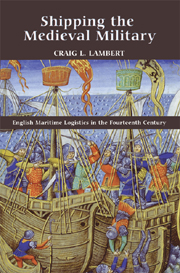Book contents
- Frontmatter
- Contents
- List of Tables
- Acknowledgments
- Abbreviations
- Introduction
- 1 Raising a Fleet
- 2 The Supply of Armies and Garrisons by Sea, 1320–1360
- 3 The Transportation of English Armies to France, 1324–1360
- 4 Maritime Resources and the King's War
- Conclusion
- Appendix 1 Ports that Supplied Ships to the Fleets
- Appendix 2 Reconstructing the Merchant Fleet: A Methodology
- Bibliography
- Index
- Warfare in History
1 - Raising a Fleet
Published online by Cambridge University Press: 12 September 2012
- Frontmatter
- Contents
- List of Tables
- Acknowledgments
- Abbreviations
- Introduction
- 1 Raising a Fleet
- 2 The Supply of Armies and Garrisons by Sea, 1320–1360
- 3 The Transportation of English Armies to France, 1324–1360
- 4 Maritime Resources and the King's War
- Conclusion
- Appendix 1 Ports that Supplied Ships to the Fleets
- Appendix 2 Reconstructing the Merchant Fleet: A Methodology
- Bibliography
- Index
- Warfare in History
Summary
Raising a fleet of ships for either transportation of troops or delivery of victuals was a complex operation. Although in the past the procedure for assembling a fleet of requisitioned merchantmen has been described as relatively straightforward a more detailed examination of the process provides evidence of an underlying sophistication. Not only was a large team of clerks required but also sergeants-at-arms, bailiffs, sheriffs and shipmasters. These groups would work separately or together in order to supply the required numbers of ships demanded by the crown. Yet the workings of this procedure and the sheer scale of the task is little understood. We do have an outline of the careers of some of the clerks and we know something of the methods they employed to raise an armada in the fourteenth century. But the system of arrest, muster and review that the clerks had to undertake in order to untangle all the information generated by the process of requisitioning large numbers of ships, from hundreds of ports, into payrolls with exact dates of service is yet to be fully appreciated. Therefore, in order to show the complexities and sophistication of this process this chapter is divided into four sections. The first section includes a discussion of the methods employed by the crown during this period to assemble a fleet. Following this is an analysis of the types of requisition orders that were issued, the implications of these orders for ship owners and a discussion on the men who organised naval expeditions.
- Type
- Chapter
- Information
- Shipping the Medieval MilitaryEnglish Maritime Logistics in the Fourteenth Century, pp. 11 - 51Publisher: Boydell & BrewerPrint publication year: 2011



